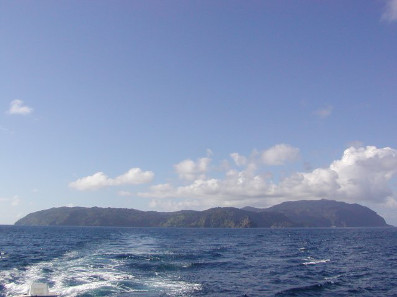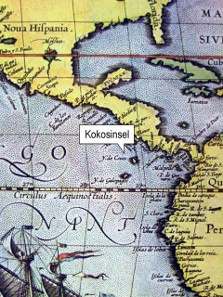by Björn Schöpe
translated by Annika Backe
April 16, 2015 – Stories revolving a fairy-tale treasure on Cocos Island allegedly inspired Robert Louis Stevenson to write his adventure novel ‘Treasure Island’. For 200 years, all attempts to recover these riches have proven unsuccessful. Now, an announcement makes everyone sit up and take notice:
Picturesquely situated Cocos Island. Photo: JRAWLS / http://creativecommons.org/licenses/by/2.0/deed.en.
After a violent storm a group of rangers were checking the breeding sites of migrating birds on Cocos Island, belonging to Costa Rica. All of a sudden, the men noticed a wooden chest protruding from the sand. Four more chests were found – all brimming with gold and silver, coins, jewelry and valuables.
Cocos Island, detail of the atlas ‘Theatrum orbis terrarum’ by Abraham Ortelius, printed in Antwerp in 1592.
The description of the items perfectly matches the famous ‘Treasure of Lima’ that is said to be buried on Cocos Island. Every zealous treasure hunter is familiar with the story:
In the first half of the 19th century, Spain lost more and more of its colonies in South America to the independence fighters. In that dangerous situation the officials and the head of the church of Lima, capital city of Peru, decided to engage a Scottish merchant to ship their valuables to Panama. The two parties signed a contract, the ship set sail – and the Scotsman preferred to keep the cargo for himself. He is said to have hidden these precious objects on Cocos Island.
About 500 expeditions searched for them without ever finding anything. The German August Gissler even had himself appointed Governor of Cocos Island so that he could take his time and search for the treasure. Together with some assistants, Gissler dug on the island for almost 15 years before he abandoned the search and left, with empty hands, in 1903.
On March 10, 2015, the online newspaper ‘World News Daily Report’ announced that an amazing 200 million dollar cache had been found, exactly like the one described above. A photo shows a gold Madonna that is said to have come from the Cathedral of Lima – estimated metal value: more than 1.4 million dollars.
Numismatists were as keen as mustard and the experts in several treasure hunter forums expressed both their envy of the lucky rangers and their wish that the latter would be allowed to keep a decent finder’s reward at least.
Only a few days later, a number of media proved that report to be a hoax. Some of the images originated from the image hosting service Flickr and official institutions in Costa Rica knew nothing about any treasure.
As a matter of fact, the site ‘World News Daily Report’ is specialized in canards and, as the disclaimer states, it assumes ‘…all responsibility for the satirical nature of its articles and for the fictional nature of their content. All characters … are entirely fictional and any resemblance between them and any persons, living, dead, or undead is purely a miracle.’
By the way, the whole story about the ‘Treasure of Lima’ is believed to be a mere legend nowadays – that treasure at least is highly unlikely to be buried on that island. The scenario, however, is realistic: even if Cocos Island harbored other pirate treasures, they could be discovered only by chance. The isle is a National Park since 1978, and any treasure hunting is strictly prohibited.
This is the news on ‘World News Daily Report‘.
Read the disclosure on Thatsfake.com.
The news were enthusiastically received by numismatists …
… and treasure hunters.
The Tropical Island and the history of its treasures were introduced in the category ‘environment’ in The Guardian.






